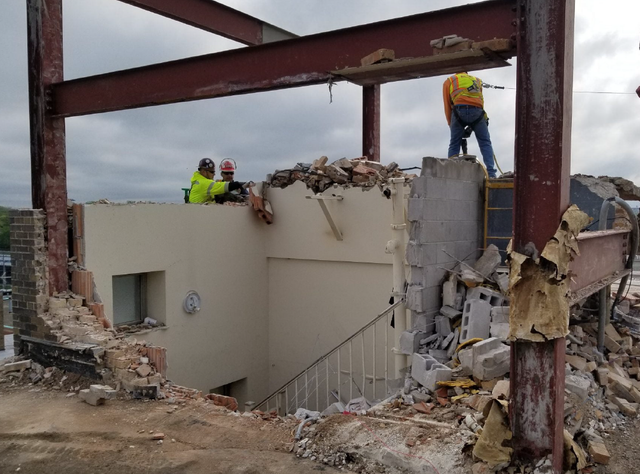Ecological Sustainability in Interior Demolition: Approaches for Liable Practices
Ecological Sustainability in Interior Demolition: Approaches for Liable Practices
Blog Article
The Ultimate Overview to Inside Demolition Techniques and Devices
Within the realm of interior remodellings, the art of demolition is a crucial phase that calls for accuracy, ability, and the right collection of devices. Whether you are a skilled specialist or a do it yourself fanatic, recognizing the intricacies of interior demolition techniques can make all the difference in achieving a successful job result. As we navigate with the nuances of this detailed overview, we will certainly discover necessary devices, precaution, and specialist strategies that are indispensable when starting the journey of changing a space. Stay tuned to uncover the vital understandings that can boost your demolition expertise to new heights.
Vital Interior Demolition Devices
When embarking on indoor demolition projects, having the proper devices is essential for effectiveness and safety and security. One of the most vital tools for interior demolition is the demolition hammer. This sturdy device is developed to break via tough products like concrete, drywall, and tile.
Its capacity to make accurate cuts in limited spaces makes it ideal for demolition work. On the whole, having these important indoor demolition tools will substantially improve the effectiveness and security of any demolition project.

Safety And Security Preventative Measures During Demolition

Additionally, all workers associated with the demolition procedure need to obtain appropriate training on the proper handling of tools and equipment to decrease mishaps. It is vital to safeguard the workplace by erecting indicators and obstacles to avoid unauthorized access - interior demolition. Routinely inspecting and keeping devices and devices can also add to a much safer working environment. By sticking to these security precautions, indoor demolition tasks can be performed efficiently while focusing on the wellness of all individuals entailed.
Techniques for Getting Rid Of Walls
Carrying out proper security preventative measures throughout indoor demolition tasks is vital for creating a safe working atmosphere, and one vital aspect of such tasks involves understanding methods for getting rid of walls. One commonly utilized approach is manual demolition, which needs making use of fundamental hand tools such as sledgehammers, crowbars, and utility knives to carefully take apart the wall surface item by piece. This strategy permits greater control over the demolition process, specifically in fragile areas where precision is essential.
For bigger, more complicated wall surfaces, mechanical demolition might be essential. This involves utilizing hefty equipment like excavators or excavators to knock down wall surfaces successfully. It is vital to make certain that the architectural honesty of the structure is not endangered throughout mechanical demolition.
An additional method for getting rid of wall surfaces is deconstruction, where the wall surface is taken apart in a manner Going Here that protects recyclable products. This sustainable approach is eco-friendly and can also help reduce disposal costs. Whichever technique is used, it is crucial to adhere to correct security methods and take into consideration the architectural ramifications of wall removal to make certain an effective interior demolition project.
Removing Floor Covering Like a Pro
Successfully getting rid of flooring during indoor demolition needs the appropriate tools and techniques to ensure a smooth and effective process. The first action in eliminating flooring is to remove the area of any furnishings or challenges. Next, recognize the sort of flooring to establish the proper elimination approach. For hardwood or laminate floor covering, begin by removing the walls and after that make use of a flooring scraper to raise and remove the planks. Rug removal entails cutting the carpeting into manageable sections and rolling it up for disposal. For tile or plastic flooring, a sculpt or floor scrape can be utilized to tear up the tiles or sheets. It's vital to wear safety gear such as handwear covers, safety glasses, and a mask to avoid injuries and direct exposure to dust and debris. In addition, having a dumpster or assigned disposal location ready for the eliminated floor covering materials is vital for maintaining a tidy workplace. By adhering to these strategies and making use of the right devices, removing flooring like a pro can be accomplished effectively and efficiently.
Proper Waste Disposal Methods
After efficiently eliminating flooring using the ideal tools and techniques, the following important step in the indoor demolition process is carrying out appropriate waste disposal methods. Correct waste disposal is great site vital for maintaining a secure and clean job setting during and after demolition.

Specialists have to follow regional guidelines regarding waste disposal to avoid fines and penalties. Making use of professional waste administration services can streamline the disposal procedure and ensure conformity with environmental guidelines. By executing appropriate waste disposal methods, interior demolition tasks can be finished successfully and sustainably.
Conclusion
Finally, interior demolition calls for the usage of essential devices and stringent security precautions to ensure a secure and effective process. Techniques for getting rid of wall surfaces and flooring have to be done meticulously and successfully to prevent any damage or mishaps. Proper garbage disposal techniques are also essential to keep a organized and tidy workspace. By adhering to these guidelines, indoor demolition can be finished efficiently and with marginal threats.
One of the most critical devices for interior demolition is the demolition hammer (interior demolition). On the whole, having these vital indoor demolition tools will dramatically enhance the performance and safety of any kind of demolition project
Successfully removing floor covering throughout interior demolition calls for the proper tools and strategies to ensure a effective and smooth process.After efficiently removing flooring utilizing the proper devices and methods, the next vital step in the indoor demolition procedure is implementing appropriate waste disposal techniques.In verdict, interior demolition requires the use of necessary devices and strict security preventative measures to make certain a safe and successful process.
Report this page